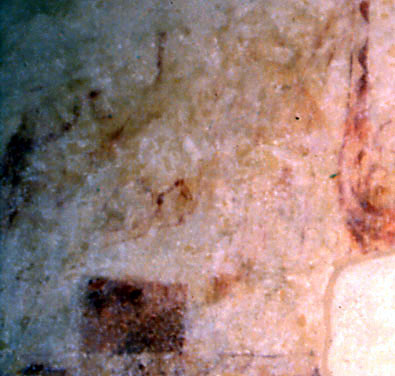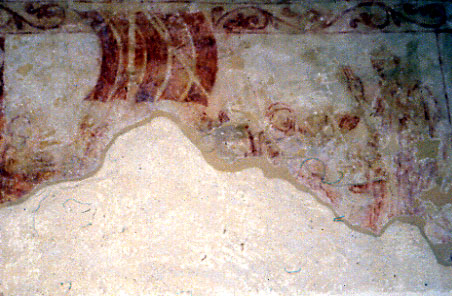Wissington, Suffolk (†St Edmundsbury & Ipswich) Late C.13
Two Miracles from the Life of St Nicholas
The Three Boys in the Barrel

One of the best-known of the miracles of St Nicholas, and certainly the most frequently found in English wallpainting, it is now desperately faint despite more than one restoration.
At the bottom centre of the scene is the roughly square red barrel, and above it an accustomed eye might be able to make out three small heads in profile (that on the right is clearest). The boys are emerging from the pickling-tub, and they have their arms stretched out horizontally to the right of the picture, where St Nicholas once stood with his mitre and pastoral cross. Only a few vague patches of yellow pigment are left of him now, but they still just manage to imply a standing figure, with the vertical spiral band dividing all the scenes at Wissington further right. There were once at least two more figures, now reduced to the patches of red pigment at the upper left – EW Tristram suggested that these were the parents of the boys; his drawing of the scene when they were were much clearer hangs in the church and, along with many of the other Wissington paintings, is reproduced in his 13th century volume.¹
The Miracle of the Cup

Much rarer, this miracle tells of a man who prayed for a son, promising a golden cup to the altar of St Nicholas if his prayer was answered. The desired son was born, and when the father received the cup from the goldsmith he liked it so much that he had a second one made. Unfortunately, on their journey by ship to the altar of St Nicholas in fulfilment of the vow, the boy, fetching his father water in the first cup, fell overboard and drowned. The cup was lost The account in the Golden Legend continues:
“Yet nevertheless the father performed his avow, in weeping much tenderly for his son; and when he came to the altar of St Nicholas he offered the second cup, and when he had offered it, it fell down, like as one had cast it under the altar. And he took it up and set it again upon the altar, and then yet was it cast further than tofore and yet he took it up and remised it the third time upon the altar; and it was thrown again further than tofore. Of which thing all they that were there marvelled, and men came for to see this thing. And anon, the child that had fallen in the sea, came again prestly before them all, and brought in his hands the first cup, and recounted to the people that, anon as he was fallen in the sea, the blessed St Nicholas came and kept him that he had none harm. And thus his father was glad and offered to St Nicholas both the two cups.” ²
The various stages of the story are compressed into one continuous scene, dominated by the fully-spread sail of the ship. A seated figure at the far left of this might be the father, with other figures, all extremely faint, those of the boy and sailors attending to the rigging. At the far right stands St Nicholas, hand raised in blessing and much clearer here, while between him and the ship are again several people, presumably the boy and his parents, in attitudes of thanksgiving, with one pair of extended hands still visible.
Nicholas’s cult is very ancient, but all accounts of his life, including that of the 9th century Methodius, are in varying degrees unreliable, and all his many miracles are as fantastical as those discussed here. None of this detracted in the slightest from his enormous popularity throughout medieval Europe, east and west.
Another painting of St Nicholas & the Three Boys at Padworth in Berkshire is now here (table below, and that at Bishopsbourne in Kent will be here soon. What is left of the example at Little Horwood in Buckinghamshire, which has fuller details of the boys-in-the-barrel incident, is already here, and there are one or two more still to come.
Most of the other paintings at Wissington are now on the site, including the Nativity, with the Virgin in bed, the Adoration and Dream of the Magi (link below), with the Magi in bed this time, a St Michael Weighing Souls, St Francis Preaching to the Birds – probably the earliest representation of the saint in England – and the remains of a Passion Cycle.
¹ Tristram 2, English Medieval Wall Painting: The 13th Century, London, 1950. Part 2, Plates, Pl. 185b. (Tristram, incidentally, refers to the village & church as ‘Wiston’, which remains the local pronounciation).
² This is Caxton’s translation of the Golden Legend, according to which the second cup was of the same value as the first, but the usually reliable Anna Jameson, who was presumably using a different source or a different version of the Legend, specifically describes the second cup as made of silver. (A Jameson, Sacred & Legendary Art, Vol 2, 3rd edition, London, 1857, p. 463). The extract on this page is taken from the online Golden Legend: Life of St Nicholas.